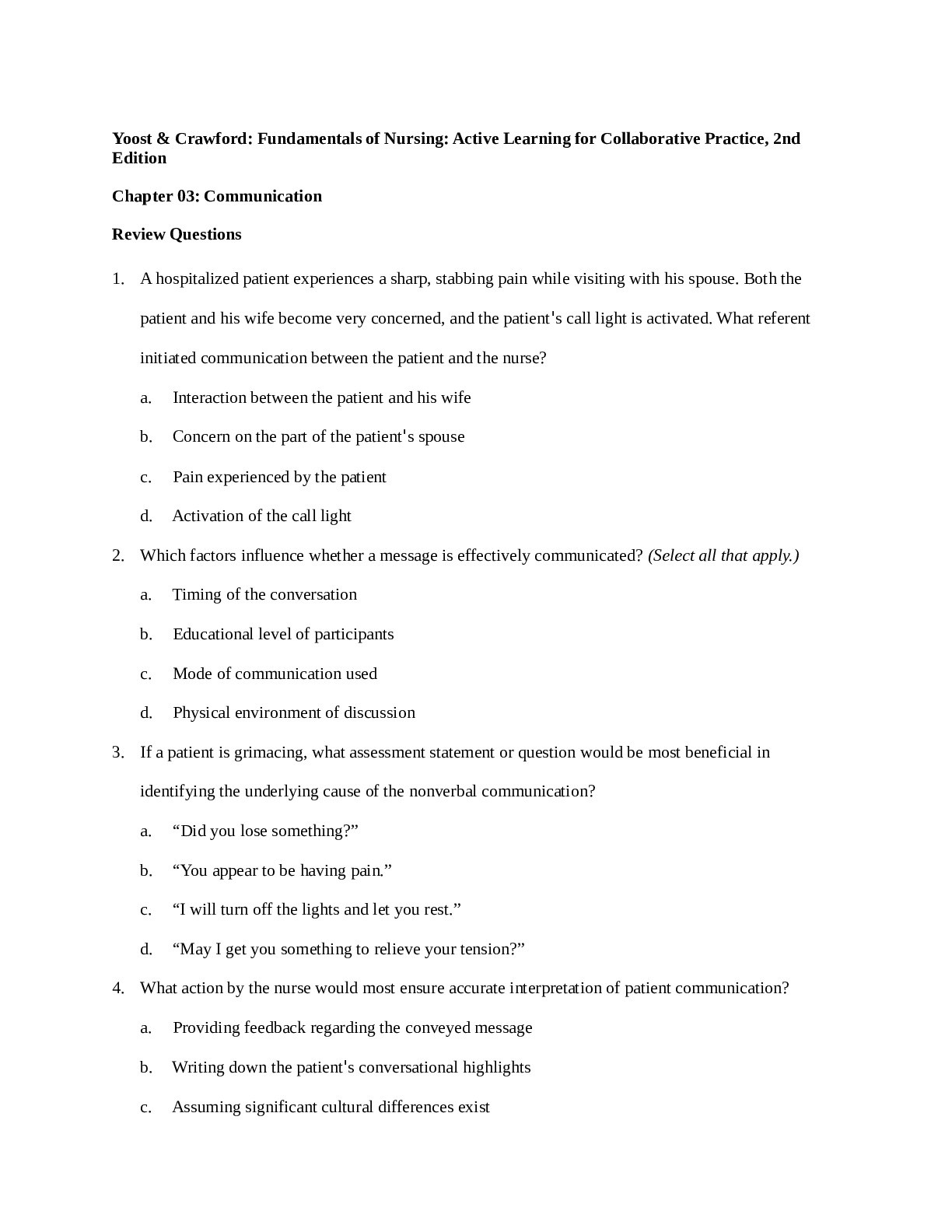All study resources > Yoost & Crawford: Fundamentals of Nursing: Active Learning for Collaborative Practice, 2nd Edition (Nursing)
Yoost & Crawford: Fundamentals of Nursing: Active Learning for Collaborative Practice, 2nd Edition
1. A hospitalized patient experiences a sharp, stabbing pain while visiting with his spouse. Both the
patient and his wife become very concerned, and the patient's call light is activated. What referent
initiated communication between the patient and the nurse?
a. Interaction between the patient and his wife
b. Concern on the part of the patient's spouse
c. Pain experienced by the pat
...[Show More]
1. A hospitalized patient experiences a sharp, stabbing pain while visiting with his spouse. Both the
patient and his wife become very concerned, and the patient's call light is activated. What referent
initiated communication between the patient and the nurse?
a. Interaction between the patient and his wife
b. Concern on the part of the patient's spouse
c. Pain experienced by the patient
d. Activation of the call light
2. Which factors influence whether a message is effectively communicated? (Select all that apply.)
a. Timing of the conversation
b. Educational level of participants
c. Mode of communication used
d. Physical environment of discussion
3. If a patient is grimacing, what assessment statement or question would be most beneficial in
identifying the underlying cause of the nonverbal communication?
a. “Did you lose something?”
b. “You appear to be having pain.”
c. “I will turn off the lights and let you rest.”
d. “May I get you something to relieve your tension?”
4. What action by the nurse would most ensure accurate interpretation of patient communication?
a. Providing feedback regarding the conveyed message
b. Writing down the patient's conversational highlights
c. Assuming significant cultural differences exist
d. Verifying the patient's emotional state
5. If a patient's verbal and nonverbal communications are inconsistent, which form of communication is
most likely to convey the true feelings of the patient?
a. Written notes
b. Facial expressions
c. Implied inferences
d. Spoken words
6. What strategy would be most effective in communicating with a highly anxious adult immediately
before surgery?
a. Providing specific, concise instructions
b. Detailing likely causes of their anxiety
c. Focusing on postoperative details
d. Using instructional multimedia DVDs
7. What action should the nurse take if an alert and oriented patient asks the nurse for personal contact
information?
a. Ask the patient why the personal information is needed.
b. Report the interaction to the nursing supervisor immediately.
c. State that it would not be appropriate to share that information.
d. Change the subject, and hope that the patient does not ask again.
8. What would be the best therapeutic response to a patient who expresses indecision about
recommended chemotherapy treatments?
a. “Can you tell me why you are undecided?”
b. “It's always a good idea to have chemotherapy.”
c. “What are you thinking about the treatments at this point?”
d. “You should follow whatever your health care provider recommends.”
9. Which statement is most accurate regarding symbolic expression?
a. Skills confidence can be shared most effectively by nurses through wearing distinctive clothing.
b. Clothing choices by a hospitalized patient rarely reflects his or her economic resources.
c. Make-up use by a patient is unnecessary for any reason during hospitalization.
d. Nondramatic make-up use and minimal accessorizing by nurses demonstrates professionalism.
10. Which defense mechanism is being exhibited when a 27-year-old patient insists on having a parent
present during routine care?
a. Denial
b. Regression
c. Repression
d. Displacement
[Show Less]
